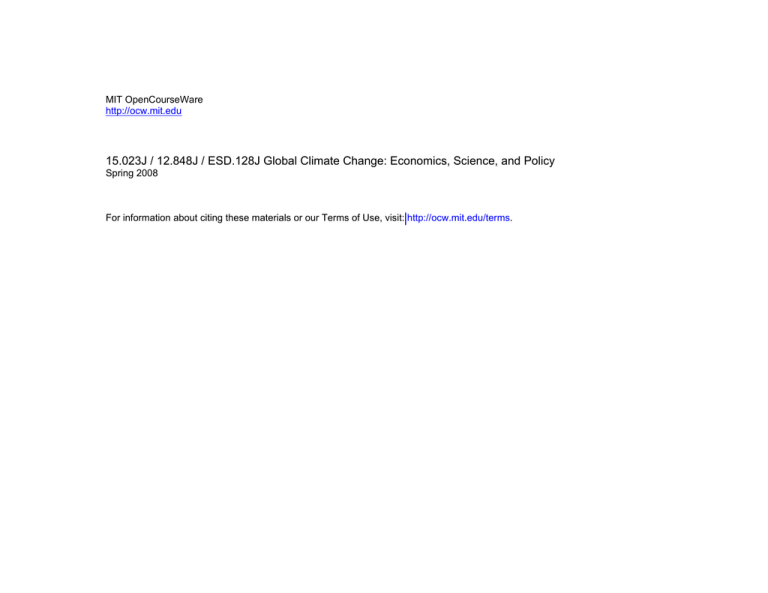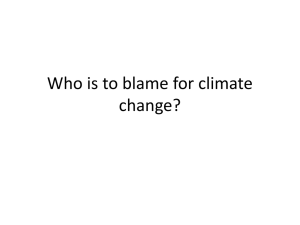15.023J / 12.848J / ESD.128J Global Climate Change: Economics, Science,... MIT OpenCourseWare Spring 2008 rms of Use, visit:
advertisement

MIT OpenCourseWare http://ocw.mit.edu 15.023J / 12.848J / ESD.128J Global Climate Change: Economics, Science, and Policy Spring 2008 For information about citing these materials or our Terms of Use, visit: http://ocw.mit.edu/terms. Institutions II: International Climate Negotiations • Evolution of Kyoto “architecture” – How might it have gone better? – Why the big national differences? • Venue and architectural alternatives • The road to Bali • What path(s) to an international regime? Fragmentation of the Kyoto Regime UN General Assembly Framework Convention on Climate Change COP Conference of Parties 2012 2008 commitment U.S. 2d period 1st commitment period MOP Kyoto Ä Tighten, Add LDCs Protocol Treaty Bureaucracy Ratif’n by 55% Legal Force Annex B (OECD, Econs. In Transition) Non-Annex B (Developing Countries) The Evolution: 1992 in Rio • Negotiations within the U.N. system – In the context of UNCED in 1992 • National targets and timetables – Concept: national quantity targets – “Aim” to return to 1990 by 2000 – “Grandfathered” emissions at national level • “Common but differentiated responsibilities” – Annex I vs. Non-Annex I Q: What alternatives were available? The Evolution: COP-1 in Berlin • Mandated that negotiators agree to – Emissions targets for 2005, 2010, 2020 – Common “policies and measures” • No discussion allowed of Non-Annex I emissions commitments • Six-gas bundle • Protocol to be prepared for agreement by COP-3, in Kyoto in 1997 Q: Were mistakes made here? The Evolution: 1997 in Kyoto • Agreed – Fixed quantity targets for 2008-2012, unrelated to growth – Commitments for Annex B nations only – Flexibility mechanisms & ”new effort” sinks • Not agreed – Restrictions on buying reductions abroad – “Do nothing” sinks – Compliance penalties Q: What outcomes would have been better? Final Protocol Steps • Kyoto ¼ COP-6 (11/00): collapse on details • Bush rejects Kyoto (3/01), quits negotiations • Agreement in Bonn (7/01) & Marrakech (11/01) . . . without the US) – Relax targets by “do nothing” sinks • Bonn: 54 MMtC for Canada, Japan, Russia • Marrakech: another 15.4 MMtC for Russia – Dropped restrictions on emissions trading • Deferred issue of compliance penalties Q: Were opportunities missed in this period? Why Such Conflict? • Perception of differences in attitude – US, EU, Japan, Canada, Australia, Russia • Why? – Role of industry vs. government – Public attitudes & environmental politics – Fiscal interactions – Role of NGOs – Culture/traditions Others? – National policy structures – International negotiating process Bush Proposal: Feb. 2002 • R&D and subsidies to new technology • 10-year GDP-linked reduction target • Voluntary programs to achieve it – Registry of emissions (still being designed) – Firms can record reductions, get credit against any follow-on mandatory scheme (?) • Promise more action in 2012, if intensity goal isn’t met and “the science warrants” • Bilateral and multi-lateral technology agreements Action in Other Venues • U.S. multilateral initiatives – Methane to Markets – Asia-Pacific Partnership on Clean Development and Climate (AP6) – Major Emitters Conference(s) • Initiatives by the EU and others • Group of 8 (summit meetings) • Greenland Dialogue Subsequent COP/MOP Activity • Many details of implementation • Compliance – Amendment vs. “decision” • CDM – Clear bureaucratic underbrush • Residual sinks issues – Credit for stopping deforestation? • “Dialog” on long-term cooperative action – How to address the post-2012 question The Path to Bali • “Seminars” in previous COPs • The conflict in Bali (& the footnote) • Bali action plan – Provisions (& the political fingerprints) – Timing Classification of recent (Post-Third Assessment Report) stabilization scenarios according to different stabilization targets and alternative stabilization metrics Additional radiative CO2 CO2 - eq forcing concentration concentration Category (W/m2) (ppm) (ppm) I II III IV V VI 2.5-3.0 3.0-3.5 3.5-4.0 4.0-5.0 5.0-6.0 6.0-7.5 350-400 400-440 440-485 485-570 570-660 660-790 445-490 490-535 535-590 590-710 710-855 855-1130 Global mean temperature increase above pre-industrial at equilibrium, using "best estimate" climate sensitivity (oC) Peaking year for CO2 emissions Change in global CO2 emissions in 2050 (% of 2000 emissions) No. of assessed scenarios 2.0-2.4 2.4-2.8 2.8-3.2 3.2-4.0 4.0-4.9 4.9-6.1 2000-2015 2000-2020 2010-2030 2020-2060 2050-2080 2060-2090 -85 to -50 -60 to -30 -30 to +5 +10 to +60 +25 to +85 +90 to +140 6 18 21 118 9 5 Total 177 Figure by MIT OpenCourseWare. No Shortage of Proposals, e.g. • KP-type targets & timetables (Reductions from baseline, rolling negotiations) – Wealth trigger for accession – Role of “historical responsibility” – Path to equal tons per capita • Targets & timetables with emissions trade – Head-room provided to Non-Annex B – International safety valve • Harmonized carbon taxes More Proposals • International fund to buy reductions – By direct aid (perhaps development related) – Through an emissions trading regime • Portfolio of policies and measures – Implementation by pledge and review – Targets and timetables as only a loose guide • Protocol on R&D and demonstration Wide open, awaiting the dialogue What Path to Coherence? • What venue? • Who is involved? • What form of agreement? • What actions? • What timing? FCCC COP Sec’y SBSTA SBI Kyoto Protocol US & Others MOP ? Web Sites • www.ipcc.ch • www.unfccc.int • http://globalchange.mit.edu/ • www.weathervane.rff.org • www.pewclimate.org






